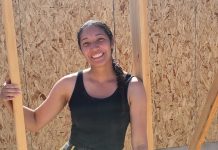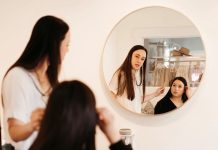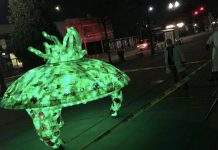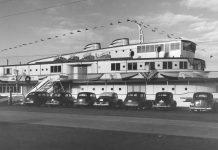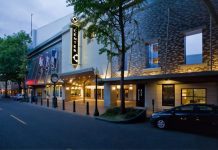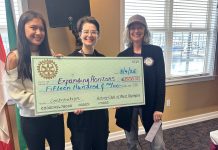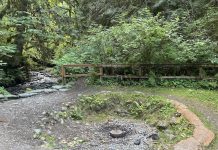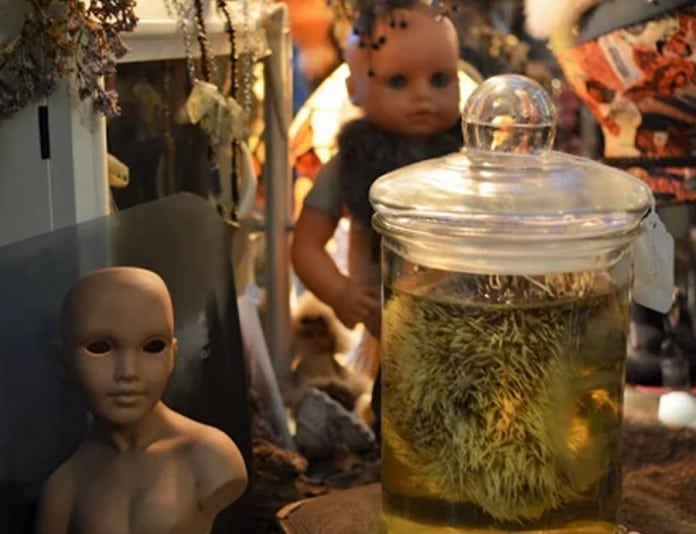
By Mariah Beckman
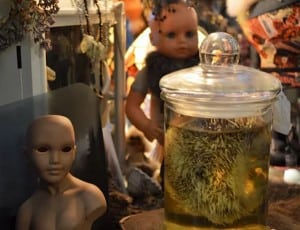
Mishele Winter, clad in carnival-striped stockings and a lace-trim denim skirt, could be any of Tacoma’s eclectic creatives at first glance. Her cheeky graphic tee — a cat donning an astronaut helmet — and sleeve of vibrant tattoos speaks to her free-spirited ease, but there is something stately about her, too. Something very definite about her presence in the room.
Not far from the entryway of her current space, near the far end of Tacoma’s Freighthouse Station, Mishele is laying recycled paper bags, vintage wallpaper and aging book pages along the stripped cement; these will be stained and coated to serve as the new floor for her updated, larger space in the same mall. This storefront — which will be ready “when it’s done” — will comfortably accommodate her expanding boutique as well as her husband, Justin Winter’s, growing tattoo parlor.
As the owner of the Wunderkammer Curiosity Shoppe, Mrs. Winter makes a living out of repurposing discarded things. She seems to be in her element as she outfits her Tacoma studio, and all around her, on tables and bookcases and unmounted shelves, are strewn imaginative and carefully handcrafted works of art that she has crafted herself.
Wunderkammers have their origins far from the beaches of the Puget Sound, dating all the way back to 16th-century Europe. In order to satisfy a titillating curiosity for knowledge of unknown lands, mythical animals and other machinations at the far, mysterious ends of the earth, the Wunderkammer was born.
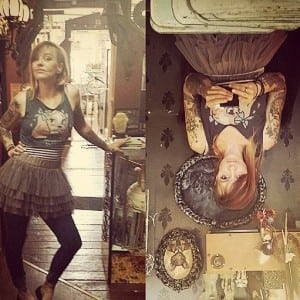
“In German,” Mishele explains, “a kammer is cabinet, which means room, and these rooms were full of scientific and awe-inspiring — wondrous — things. They began with the idea of enlightenment, and there was a split between the divine and science right around the time that first Wundkerkammers came to be.”
“There’s not enough “wow” left in the world,” this artist muses as her eyes wander to her own sculptures. “We can’t even grasp the wonder that people felt in the 15th-century at the idea of a rhinoceros. So much of the lore that we still share today originated from whispers and tall tales of, say, of a manatee, of a narwhal — those were mermaids. Before anyone ever laid eyes on a rhinoceros, it had already evolved in imaginations as a powerful horse with a horn: a unicorn.”
Wonders both natural and man-made were prized baubles in personal collections of early curiosity aficionados. Procured, composed and auctioned by scholars and apothecaries, kings and pirates, scholars and noblemen, trifles small and large were collected as trophies, proof of peculiar animal specimens or foreign artifacts that were remarkable or unnamed.
While curio cabinets today may hold antiquated tokens or heirlooms, the Wunderkammers of the Victorian and Gothic eras were most often relic-strewn sitting rooms or parlors, chock full of bizarre, kinky and absurd treasures. Within these fantastic dens and sanctuaries, rumors of monsters and miracles were debunked, exotic flowers and herbs were cultivated or preserved and bold claims of strange new lands were substantiated and on display, offering up a veritable living library for the curious mind.
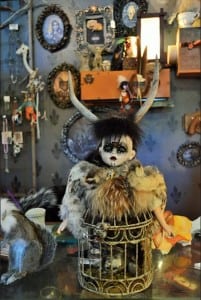
Shoppe.
Eventually a distinction emerged among collections, and then an evolution. Mishele explains that Wonderkammers were more about awe, while curiosity cabinets became more about scientific study: this genus or that one; labels and explanations. Traveling fairs and carnivals — both of which predate menageries or zoos as society knows them today — became a sort of extension of either nuance, a movable museum of the warped and the unknown. The sights that visitors could see in a private show or caravan influenced art and science for generations and would later contribute to growth during the Age of Enlightenment.
Even now, in the 21st century, artists like Mishele continue to draw inspiration and a sense of awe from collections such as these. She explains that the first curiosity cabinets have been heralded as a grandfather of the modern encyclopedia, giving rise to contemporary art and history museums, botanical gardens and, the close cousin of curiosity shops, the circus freak show.
She explains that modern curiosity shops have developed a bent toward taxidermy, which she herself is very smitten with. “Taxidermy and mummification in wunderkammers are built upon the idea that if you can’t find that wonder that you crave in the natural world, then you’re going to create it.”
It was with this yearning for a sense of amazement that Mishele Winter began to teach herself how to craft the unusual artifacts that are drawing a steady crowd to her South Sound boutique.
There is a wide variety of artwork and oddities at the Wunderkammer Curiousity Shoppe, but the pieces that Mishele curates are perhaps the most alluring. Her sculptures are the fodder of Mary Shelley’s “Frankenstein,” as whimsical and provocative as they are macabre and obscene. “I was a nursing major,” Mishele says. “I love science, I love anatomy, I love biology. And the internet is a wonderful thing. I’m self-taught, and I have some intentional mummification pieces in the shop, but I do stuff that’s closer to taxidermy most often.”
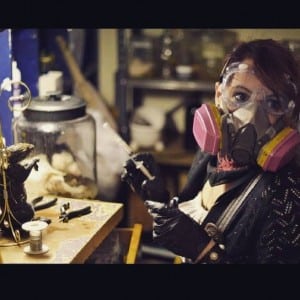
This Wunderkammer began, as most incredible things do, organically. Mishele brought some of her hand-crafted sculptures and taxidermy to her husband’s tattoo shop, American Ritual Tattoo, with the goal of enlivening the parlor. A few of her creative friends had an odd article here or there that they wanted to contribute, and before long the couple had a collection. Not long after that, an interest developed among tattoo patrons to acquire this one-of-a-kind décor for themselves.
From this humble beginning, Mishele says that a beautiful idea took shape: the couple could continue to furnish their space with unusual and remarkable art, and even support local artists and artisans, if they began to routinely sell curios at their studio. Mishele set to work, putting out a call on Facebook for all local creative minds to bring in their unique and handmade wares. The results spoke for themselves: there was a demand, and there were more than enough artists who were interested to justify a space. So without much ado, Mishele knocked down a wall across from her husband’s tattoo shop, and in no time the Tacoma Wunderkammer was born.
The results have been overwhelmingly positive, and the shop’s growth speaks for itself. The space Mishele shares now with her husband is as kitschy and quaint as Seattle’s Ye Olde Curiousity Shop, but with a much more curated and discerning flair. Locally sourced jewelry with a steampunk or gothic lilt lines the walls, and dozens of doctored dolls pepper the countertops for sale as lamps or eerie sculptures. Animals of all shapes and sizes are cured or mummified in evocative repose. Jars line a mirrored wall, full of preserved critters like hedgehogs, sheep, pigs, snakes, and even a marmoset monkey. And other odds and ends, some the stuff of fantasy and others haunting and a touch ghoulish, are on offer consistently. The inventory changes frequently, which Mishele says is what keeps so many customers coming back and bringing their friends.
Once the new shop opens, Mishele plans to expand her market. “I definitely want to get in more apothecary type stuff,” she says, “and a wide variety: minerals, exotic bone art, taxidermy, punk rock clothes. If it’s something that I would want to buy, I’d like to offer it at the Wundkammer.”
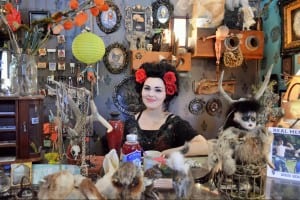
When Mishele isn’t busy working at her shop, renovating her new space or creating fresh installations, this Tacoma artist is preparing for local shows, art fairs and exhibitions. This summer her work will be on display at the Foss Waterway Seaport from July 16 to August 30, along with dozens of other local artists who share her love of inspiring awe in the natural — and unnatural — world. She is currently considering new artwork and items for consignment, and can be spotted most days behind the counter of her one-of-a-kind showroom at Tacoma’s Freighthouse bazaar.
The show:
WUNDERKAMMER: Artifacts, False Memories and Projections, opens July 16 through August 30.
The shop:
Wunderkammer Curiousity Shoppe
440 East 25th #42
Tacoma, Washington
253-459-9782

